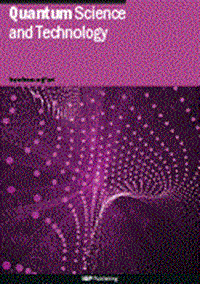Quantum simulation of boson-related Hamiltonians: techniques, effective Hamiltonian construction, and error analysis
IF 5.6
2区 物理与天体物理
Q1 PHYSICS, MULTIDISCIPLINARY
引用次数: 0
Abstract
Elementary quantum mechanics proposes that a closed physical system consistently evolves in a reversible manner. However, control and readout necessitate the coupling of the quantum system to the external environment, subjecting it to relaxation and decoherence. Consequently, system-environment interactions are indispensable for simulating physically significant theories. A broad spectrum of physical systems in condensed-matter and high-energy physics, vibrational spectroscopy, and circuit and cavity QED necessitates the incorporation of bosonic degrees of freedom, such as phonons, photons, and gluons, into optimized fermion algorithms for near-future quantum simulations. In particular, when a quantum system is surrounded by an external environment, its basic physics can usually be simplified to a spin or fermionic system interacting with bosonic modes. Nevertheless, troublesome factors such as the magnitude of the bosonic degrees of freedom typically complicate the direct quantum simulation of these interacting models, necessitating the consideration of a comprehensive plan. This strategy should specifically include a suitable fermion/boson-to-qubit mapping scheme to encode sufficiently large yet manageable bosonic modes, and a method for truncating and/or downfolding the Hamiltonian to the defined subspace for performing an approximate but highly accurate simulation, guided by rigorous error analysis. In this pedagogical tutorial review, we aim to provide such an exhaustive strategy, focusing on encoding and simulating certain bosonic-related model Hamiltonians, inclusive of their static properties and time evolutions. Specifically, we emphasize two aspects: (1) the discussion of recently developed quantum algorithms for these interacting models and the construction of effective Hamiltonians, and (2) a detailed analysis regarding a tightened error bound for truncating the bosonic modes for a class of fermion-boson interacting Hamiltonians.玻色子相关哈密顿量的量子模拟:技术、有效哈密顿量构造和误差分析
基本量子力学提出,一个封闭的物理系统始终以可逆的方式演化。然而,控制和读出需要量子系统与外部环境的耦合,使其松弛和退相干。因此,系统-环境相互作用对于模拟物理上重要的理论是必不可少的。在凝聚态和高能物理、振动光谱学、电路和腔QED中,广泛的物理系统需要将玻色子自由度(如声子、光子和胶子)纳入优化的费米子算法中,以用于不久的将来的量子模拟。特别是,当量子系统被外部环境包围时,其基本物理通常可以简化为与玻色子模式相互作用的自旋或费米子系统。然而,诸如玻色子自由度大小之类的麻烦因素通常会使这些相互作用模型的直接量子模拟复杂化,因此需要考虑一个全面的计划。该策略应特别包括一个合适的费米子/玻色子到量子比特的映射方案,以编码足够大但可管理的玻色子模式,以及一种截断和/或将哈密顿量向下折叠到定义子空间的方法,以便在严格的误差分析指导下进行近似但高度精确的模拟。在这个教学教程回顾中,我们的目标是提供这样一个详尽的策略,重点是编码和模拟某些玻色子相关的模型哈密顿量,包括它们的静态特性和时间演化。具体来说,我们强调了两个方面:(1)讨论了这些相互作用模型的最近发展的量子算法和有效哈密顿子的构造;(2)详细分析了截断一类费米子-玻色子相互作用哈密顿子的玻色子模式的收紧误差界。
本文章由计算机程序翻译,如有差异,请以英文原文为准。
求助全文
约1分钟内获得全文
求助全文
来源期刊

Quantum Science and Technology
Materials Science-Materials Science (miscellaneous)
CiteScore
11.20
自引率
3.00%
发文量
133
期刊介绍:
Driven by advances in technology and experimental capability, the last decade has seen the emergence of quantum technology: a new praxis for controlling the quantum world. It is now possible to engineer complex, multi-component systems that merge the once distinct fields of quantum optics and condensed matter physics.
Quantum Science and Technology is a new multidisciplinary, electronic-only journal, devoted to publishing research of the highest quality and impact covering theoretical and experimental advances in the fundamental science and application of all quantum-enabled technologies.
 求助内容:
求助内容: 应助结果提醒方式:
应助结果提醒方式:


